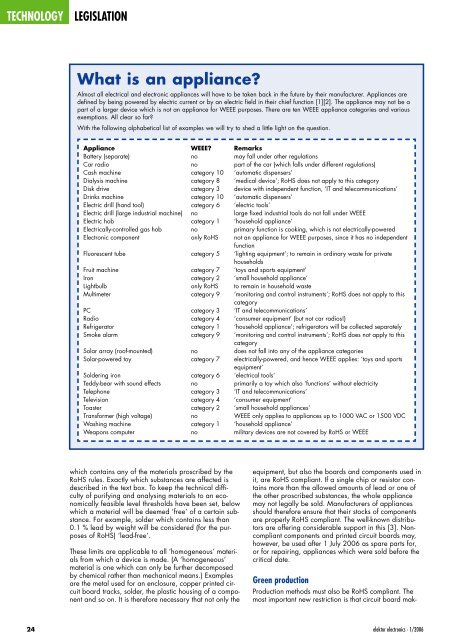FREE VB COURSE - Index of
FREE VB COURSE - Index of
FREE VB COURSE - Index of
Create successful ePaper yourself
Turn your PDF publications into a flip-book with our unique Google optimized e-Paper software.
TECHNOLOGY LEGISLATION<br />
24<br />
What is an appliance?<br />
Almost all electrical and electronic appliances will have to be taken back in the future by their manufacturer. Appliances are<br />
defined by being powered by electric current or by an electric field in their chief function [1][2]. The appliance may not be a<br />
part <strong>of</strong> a larger device which is not an appliance for WEEE purposes. There are ten WEEE appliance categories and various<br />
exemptions. All clear so far?<br />
With the following alphabetical list <strong>of</strong> examples we will try to shed a little light on the question.<br />
Appliance WEEE? Remarks<br />
Battery (separate) no may fall under other regulations<br />
Car radio no part <strong>of</strong> the car (which falls under different regulations)<br />
Cash machine category 10 ‘automatic dispensers’<br />
Dialysis machine category 8 ‘medical device’; RoHS does not apply to this category<br />
Disk drive category 3 device with independent function, ‘IT and telecommunications’<br />
Drinks machine category 10 ‘automatic dispensers’<br />
Electric drill (hand tool) category 6 ‘electric tools’<br />
Electric drill (large industrial machine) no large fixed industrial tools do not fall under WEEE<br />
Electric hob category 1 ‘household appliance’<br />
Electrically-controlled gas hob no primary function is cooking, which is not electrically-powered<br />
Electronic component only RoHS not an appliance for WEEE purposes, since it has no independent<br />
function<br />
Fluorescent tube category 5 ‘lighting equipment’; to remain in ordinary waste for private<br />
households<br />
Fruit machine category 7 ‘toys and sports equipment’<br />
Iron category 2 ‘small household appliance’<br />
Lightbulb only RoHS to remain in household waste<br />
Multimeter category 9 ‘monitoring and control instruments’; RoHS does not apply to this<br />
category<br />
PC category 3 ‘IT and telecommunications’<br />
Radio category 4 ‘consumer equipment’ (but not car radios!)<br />
Refrigerator category 1 ‘household appliance’; refrigerators will be collected separately<br />
Smoke alarm category 9 ‘monitoring and control instruments’; RoHS does not apply to this<br />
category<br />
Solar array (ro<strong>of</strong>-mounted) no does not fall into any <strong>of</strong> the appliance categories<br />
Solar-powered toy category 7 electrically-powered, and hence WEEE applies: ‘toys and sports<br />
equipment’<br />
Soldering iron category 6 ‘electrical tools’<br />
Teddy-bear with sound effects no primarily a toy which also ‘functions’ without electricity<br />
Telephone category 3 ‘IT and telecommunications’<br />
Television category 4 ‘consumer equipment’<br />
Toaster category 2 ‘small household appliances’<br />
Transformer (high voltage) no WEEE only applies to appliances up to 1000 VAC or 1500 VDC<br />
Washing machine category 1 ‘household appliance’<br />
Weapons computer no military devices are not covered by RoHS or WEEE<br />
which contains any <strong>of</strong> the materials proscribed by the<br />
RoHS rules. Exactly which substances are affected is<br />
described in the text box. To keep the technical difficulty<br />
<strong>of</strong> purifying and analysing materials to an economically<br />
feasible level thresholds have been set, below<br />
which a material will be deemed ‘free’ <strong>of</strong> a certain substance.<br />
For example, solder which contains less than<br />
0.1 % lead by weight will be considered (for the purposes<br />
<strong>of</strong> RoHS) ‘lead-free’.<br />
These limits are applicable to all ‘homogeneous’ materials<br />
from which a device is made. (A ‘homogeneous’<br />
material is one which can only be further decomposed<br />
by chemical rather than mechanical means.) Examples<br />
are the metal used for an enclosure, copper printed circuit<br />
board tracks, solder, the plastic housing <strong>of</strong> a component<br />
and so on. It is therefore necessary that not only the<br />
equipment, but also the boards and components used in<br />
it, are RoHS compliant. If a single chip or resistor contains<br />
more than the allowed amounts <strong>of</strong> lead or one <strong>of</strong><br />
the other proscribed substances, the whole appliance<br />
may not legally be sold. Manufacturers <strong>of</strong> appliances<br />
should therefore ensure that their stocks <strong>of</strong> components<br />
are properly RoHS compliant. The well-known distributors<br />
are <strong>of</strong>fering considerable support in this [3]. Noncompliant<br />
components and printed circuit boards may,<br />
however, be used after 1 July 2006 as spare parts for,<br />
or for repairing, appliances which were sold before the<br />
critical date.<br />
Green production<br />
Production methods must also be RoHS compliant. The<br />
most important new restriction is that circuit board mak-<br />
elektor electronics - 1/2006

















